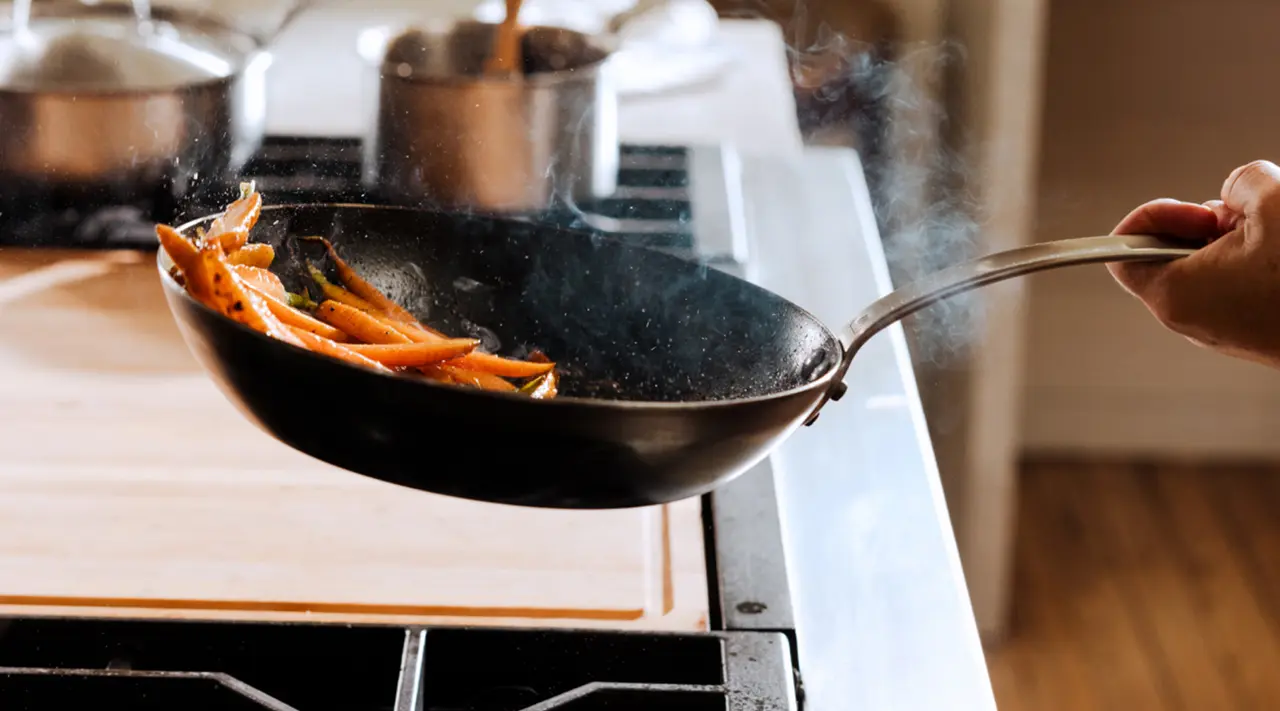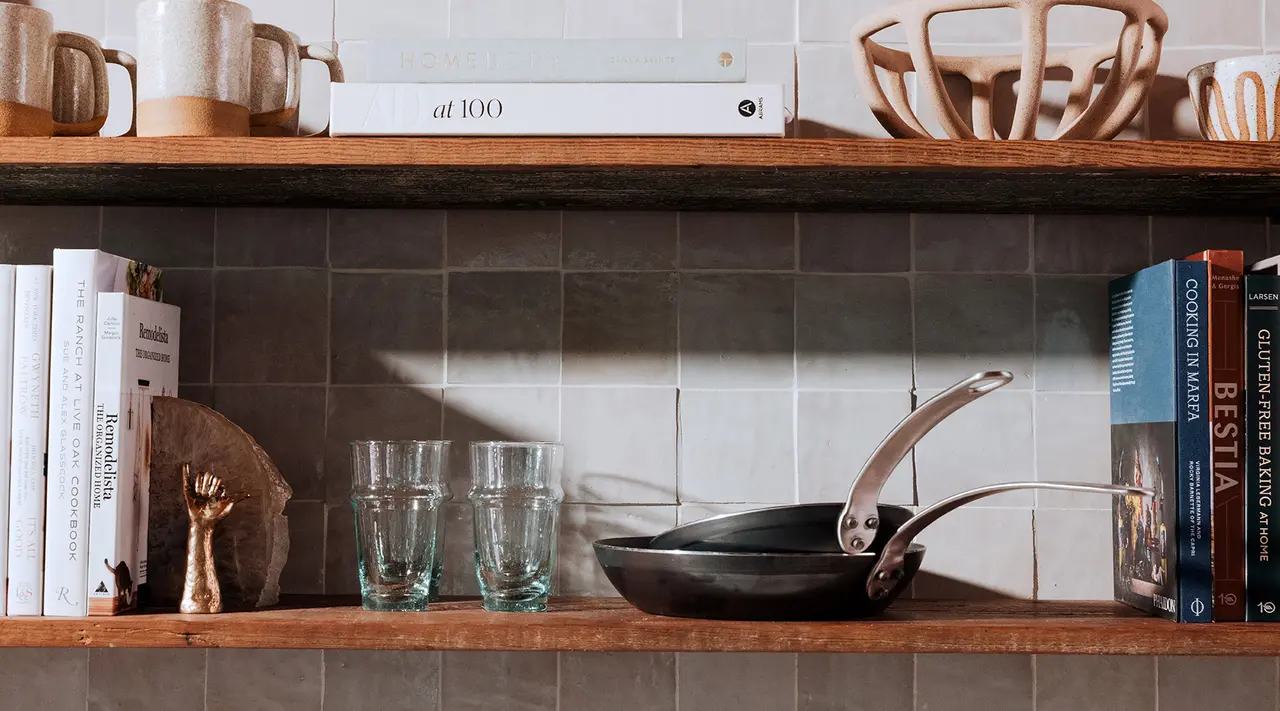It’s time to cook dinner. You have a variety of ingredients to whip up a quick stir fry. Do you reach for a wok or a frying pan?
Woks and frying pans are two distinct and unique pieces of cookware. While you can use them somewhat interchangeably, there are certain dishes and techniques in which each one shines more than the other. (Take our hypothetical above: you can make a stir fry in both a wok and a skillet, but a wok will make things much easier.)
Below we’ll discuss the merits of a wok and a frying pan, how they differ, and how to decide which you should choose for your kitchen. Since carbon steel is our material of choice for woks, we’ll compare carbon steel woks vs carbon steel frying pans.
What Is a Carbon Steel Wok?

A wok features tall sides slanting down into a cone shape towards the bottom, providing lots of cooking surface area. Those sloped sides trap heat, reducing your cooking time and making it easy to quickly and evenly cook vegetables, proteins, rice, and beyond. The wok’s shape also allows you to comfortably toss and flip food without food spilling all over your stove.
While you might see woks with a round bottom, those require special stoves or an insert to fit on your typical Western stove top. In Western kitchens, you’re more likely to see flat-bottomed woks, which, depending on the material, are compatible with a range of stove tops, including induction.
A carbon steel wok heats quickly, retains heat, and evenly distributes heat throughout. Once it’s properly seasoned, carbon steel also provides a naturally non stick cooking surface. Our Seasoned Carbon Steel Wok comes pre seasoned, so you can take it out of the box and start stir-frying, deep frying, steaming, or cooking over high heat without worrying about seasoning.
What Is a Carbon Steel Frying Pan?

A frying pan or skillet, on the other hand, features relatively short, flared sides and an ample, flat cooking surface. The shape makes it easy to sauté and flip various foods, while the larger amount of flat surface area (compared to a wok) makes it ideal for searing proteins and pan-frying.
Our Seasoned Carbon Steel Frying Pan, similar to the wok, comes pre seasoned, so its cooking surface is virtually non stick from the start. After cooking with it more, though—and cleaning it properly—that seasoning will build up over time, so you can even cook delicate things like fish and eggs without sticking.
Carbon Steel Wok vs. Frying Pan: 4 Key Differences

There are four notable differences in woks vs frying pans. We’ll go into each below.
Shape and Cooking Techniques:
The biggest difference between a wok and a frying pan is also the most obvious: the shape. A wok’s conical shape means it’s best for tossing ingredients within and cooking quickly over high heat. If you’ve ever made a stir fry in a frying pan, you’ve probably also gone through the slightly annoying task of cooking one or two ingredients and removing them from the pan to make room for the rest. With a wok, you don’t have to do that: the generous sides mean you have plenty of room to add all of your vegetables, protein, and rice.
Conversely, a frying pan gives you more flat surface area, which is better for searing larger amounts of proteins, like steaks or chicken thighs. You can also start something in your carbon steel frying pan on the stove, then transfer it to the oven. (You can technically do this with our carbon steel wok, too, but you’re less likely to need to, based on what you’re cooking.)
Heat Retention and Response:
Both a carbon steel wok and carbon steel frying pan heat quickly and retain heat well, but the shape results in a few differences. Our 12” Seasoned Carbon Steel Frying Pan has a flat surface diameter of 9.25”, while the 13” Seasoned Carbon Steel Wok’s flat surface area is 5.5”. Those extra inches on a frying pan make heat distribute more widely across the bottom than a wok, which will have a concentrated amount of heat across the bottom and a little less heat along the sides. That said, a wok is your best choice for cooking over high heat.
Versatility:
Both woks and frying pans are extremely versatile. A wok is best for stir-frying, deep-frying, steaming, boiling, and braising. In a frying pan, you can sear, sauté, pan-fry, make a finishing sauce, and even bake.
Seasoning and Maintenance:
Perhaps the best part of carbon steel cookware is the non stick seasoning that builds up over time. Taking care of that seasoning requires a bit of a learning curve, but since our entire carbon steel collection comes preseasoned, the hard part (the first two seasonings) is done for you.
With both the Frying Pan and Wok, you should be sure to remove food residue after cooking, wash with warm water (avoid soap with carbon steel whenever possible), and dry thoroughly before storing. For more cleaning and care instructions, head to our carbon steel care guide.
Which One Should You Choose?

If you’re trying to decide between a wok vs frying pan, the choice is—as you now understand—tricky. Choose a wok if you love to cook with high heat, make things super quickly, and make a lot of stir-fries (or dabble often in deep-frying and steaming with a bamboo steamer). Go for a frying pan if you want more precise heat control for searing and pan-frying, or if you don’t often make stir-fries.
Do You Need Both?
Of course, you can always get both a wok and a frying pan. Though they’re distinct pieces of cookware, the two complement each other very well in the kitchen, opening up a whole world of cooking techniques. Our Carbon Steel Frying Pan and Carbon Steel Wok work well on gas, electric, and induction stovetops. Ultimately, if you’re choosing between the two, it’s up to your cooking style and kitchen size.
Ready to Shop?
As the proud owner of both a wok and a frying pan, I’m happy to have the option and increased versatility when deciding what to cook. Look through our collection of Carbon Steel Cookware to choose which piece to add to your kitchen next, and get ready for many tasty stir-fries and sautés in your future.






























